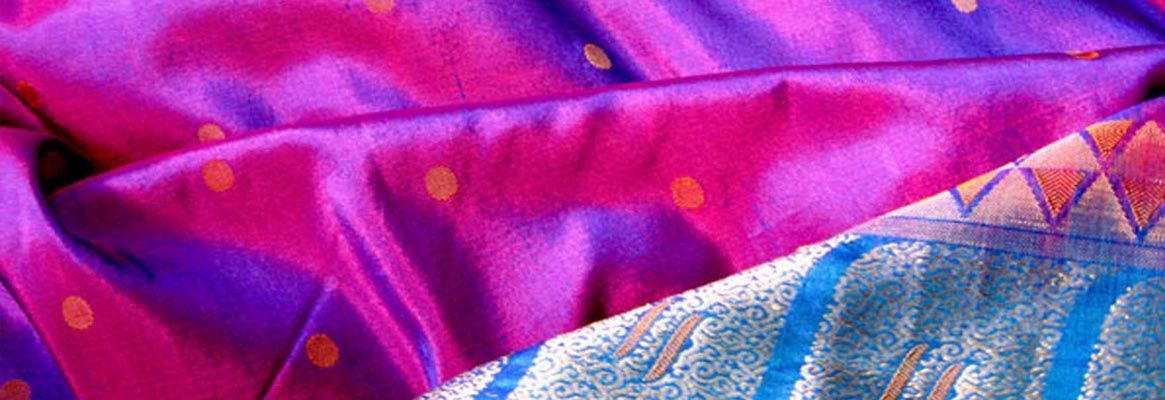Bhagalpuri lehenga have a kind of texture that looks sophisticated and plush as it is made from the finest silk threads in India. It’s loved by women all around the world as it’s a fabric that is always in demand and because of the richness that it delivers while wearing it.

Origin
Bhagalpuri silk emerged from the silk city Bhagalpur and that is how it has got its name as well. This purest and natural form of embroidered silk fabric traces emerged way back in the Vedic period, which is centuries ago. The prestigious Maurya Age dynasty also recognized this soulful artwork which attracted many kings, royal families and the elite crowd of those days as the Bhagalpuri fabric depicted richness in its shine. The attraction to this fabric passed onto the later eras which slowly and gradually uplifted the level of recognition and demand of this artwork.It’s recognition and demand has never subsided till now. Nathan Nagar in Bihar is the main city where Bhagalpuri silk is in vast numbers, and is famous all around the world, that India is the second largest producer of Bhagalpuri silk.The city of Bhagalpur is currently bestowed with over 35 thousand skilled craftsmen and 25 thousand looms, which makes it one of the prime cities that produce premium quality silk fabric in India.
Weaving
The yarns of the Bhagalpuri silk are weaved with silk threads that are naturally achieved from the Tussar cocoons. The exotic colours and the finest texture of the silk threads are from nature itself. That is why it is rightly called the Queen of all Silks. The silk threads are segregated from the Tussar cocoons and the yarns are spun and weaved to form the Bhagalpuri fabric. Being one of the oldest art forms of India, it is an environment friendly silk, because only a limited number of silks are used during the production of the Tussar silk and hence called as “Peace Silk”.

The silk which is used for making Bhagalpuri fabric are obtained from the silk worms belonging to the moth genus which feed on the leaves of the Arjuna trees. Once they grow and reach a particular stage they start forming cocoons all over them. 40% of their bodies contain larvae from which silk threads will be yielded. These trees on which the silkworms live and feed are constantly cut and kept short as these silkworms have a tendency to move in the upward direction and if they go up they are more likely to become prey and get eaten resulting in less silk production. After the cocoons are collected they are taken for silk production. Firstly the cocoons are tested for any type of allergy or irritants and are boiled in water. This process helps to loosen up the threads.
Next step is the pre-weaving. This work is usually done by women. During the earlier days, threads were manually rubbed on the thighs for reeling. Nowadays, with the advancement in technology, machines are used in the process of reeling.

The threads are then sent for the dyeing process. Initially natural dyes extracted from vegetables and flowers were used to dye the threads which have been replaced by chemical dyes. Bhagalpuri sarees are dyed in vibrant colours like red, brick, orange, yellow, blue and green making them suitable for traditional occasions. Finally these dyed yarns are fixed onto the looms for the weaving process and we get the final product.

Varieties of Bhagalpuri fabric
There are many specialties and varieties that enhance and spread the beauty of this artwork to a greater extent. Varieties like Katia, Giccha, Eri, Mulberry and various varieties of Tussar silk yarn facilitate in giving this fabric a pastoral look and provide an essence of delicateness to its texture. These varieties are known to give the fabric a rich and a royal outlook and retain the enchanting designs and motifs imprinted in them.

Specialities of bhagalpuri fabric lehenga
These silks are often not gaudy and can be worn on all weather conditions .They have a simplistic and elemental charm in them that look simple and classy. These lehenga come in vibrant colours like red, yellow, fuchsia, blue and green. The white palette is often used too, colours like ivory, beige and pure white lehenga are great for a morning beach side wedding and religious ceremonies.They are very versatile in nature and can render your persona with a dynamic edge.

With its growing demand and interest, international ramps and fashion shows have started to include these fabrics for display which has attracted millions of garment manufacturers abroad.


Perfect wedding dress
Bhagalpuri silk lehenga is one of the finest Indian dresses with matchless quality in texture and sheen . The durability of the bhagalpuri silk lehenga choli for ladies is one of the biggest reasons this dress is a perfect staple for the ethnic wardrobes, as many brides want to keep their wedding dress and pass it on to their daughters.

Styling tip
you can try the latest bhagalpuri silk lehenga choli in minimal work and wear it with matching Indian earrings for an understated regal look during engagement ceremony, and also, you can don classic Indian fashion jewelry sets with heavily embellished lehenga to match your style for the huge Indian wedding extravaganza.Pure Gold and Silver jewelry can compliment this fabric. kundan and Pearl jewelry can also gel well with the look of this fabric.

Maintenance
Initially dry washes are suggested to maintain the richness and brightness of the fabric, after which gentle hand washes can sustain the beauty and longevity of the fabric.
